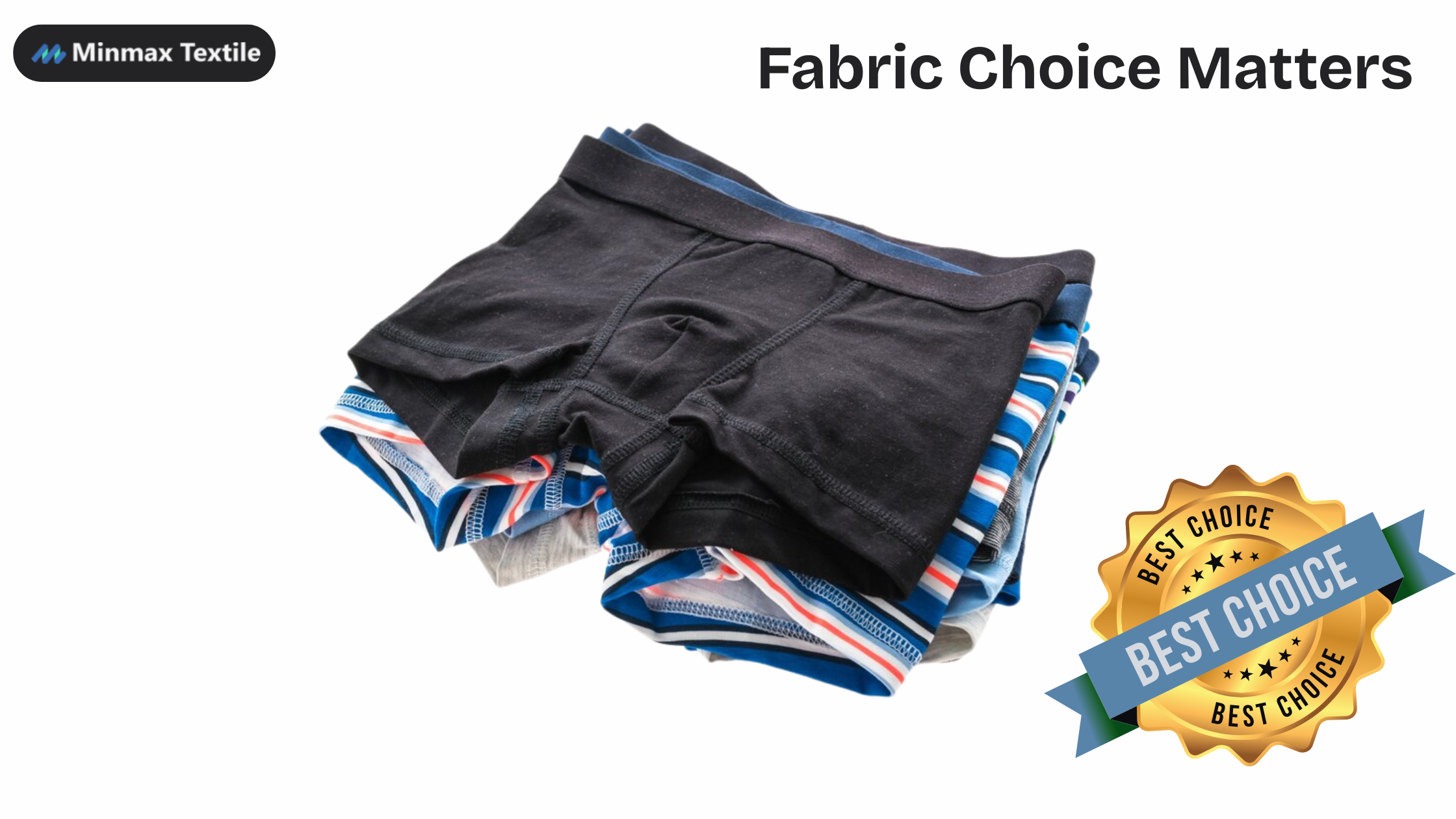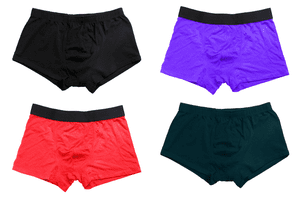When it comes to choosing the right fabric for men’s underwear, the stakes are higher than they might seem. Sure, it???s not brain surgery, but wearing the wrong pair of undies can feel like a major operation gone wrong. The right fabric can mean the difference between comfort and an all-day itch-fest, between feeling cool and collected and experiencing swamp-like conditions down there.
Now, I’m not just talking about looking good (though, let’s be honest, we all want that), but about feeling good and staying healthy. So, whether you’re a boxer guy, a briefs enthusiast, or you prefer the best of both worlds with boxer briefs, this guide is here to help you navigate the myriad fabric choices available.
So, let???s dive right in and explore why choosing the right fabric for men’s underwear matters and how you can choose the best one for you.

Why Fabric Choice Matters
Choosing the right fabric for men’s underwear isn???t just about comfort; it’s a matter of health and practicality too. Let???s break down the reasons why fabric choice is crucial:
1.Comfort and Fit
Think about it. Your underwear is the first thing you put on and the last thing you take off. It???s in constant contact with some of the most sensitive parts of your body. The right fabric can make you feel like you???re walking on air, while the wrong one can feel like you???re wrapped in sandpaper.
2.Breathability and Moisture-Wicking Properties
No one likes feeling damp and uncomfortable. Breathable fabrics like cotton or bamboo help keep things airy and dry by wicking moisture away from the body. This is especially important if you live in a hot climate or lead an active lifestyle.
3.Durability and Longevity
Nobody wants to keep replacing their underwear every few months. Durable fabrics like microfiber or modal not only feel great but also stand up to multiple washes without losing their shape or softness.
4.Impact on Skin Health and Allergies
If you have sensitive skin or allergies, the fabric you choose can make a big difference. Natural fabrics like cotton and bamboo are less likely to cause irritation or allergic reactions compared to synthetic ones.
Common Fabrics Used in Men’s Underwear
When it comes to men’s custom underwear, the variety of fabrics available can be mind-boggling. Each type of fabric has its unique characteristics, pros, and cons. Let’s explore the most common fabrics used in men’s underwear.
1.Cotton
Cotton is the king of comfort when it comes to underwear. It’s the go-to choice for many men, and for good reason.
- Pros: Cotton is a natural fiber that is highly breathable, soft, and hypoallergenic, making it ideal for sensitive skin. It absorbs moisture well, which helps in keeping you dry.
- Cons: However, cotton can retain moisture, which means it might not be the best choice for high-intensity activities where sweat is a factor. It also lacks the stretch and durability of some synthetic fabrics.
2.Modal
Modal is a type of rayon made from beech tree pulp, and it???s known for its incredible softness.
- Pros: Modal is softer and more absorbent than cotton. It???s breathable, has excellent moisture-wicking properties, and is environmentally friendly due to its sustainable production process.
- Cons: Modal can be less durable than synthetic fabrics, particularly if not cared for properly. It also tends to be more expensive.
3.Microfiber
Microfiber is a synthetic fiber made from polyester and polyamide. It???s designed to provide a smooth and silky feel.
- Pros: Microfiber is smooth, moisture-wicking, durable, and quick-drying. It???s perfect for athletic activities because it keeps you dry and comfortable.
- Cons: The main downside is that it???s less breathable than natural fibers. Some people might find it causes static or irritation.
4.Bamboo
Bamboo fabric is derived from bamboo pulp and has been gaining popularity due to its eco-friendly nature.
- Pros: Bamboo is soft, breathable, antibacterial, and hypoallergenic. It???s also an excellent moisture-wicker, keeping you dry and comfortable.
- Cons: Bamboo fabric can be expensive and less durable than some synthetic fabrics. It requires proper care to maintain its properties.
5.Silk
Silk is synonymous with luxury and is often used for special occasion underwear.
- Pros: Silk is incredibly smooth, lightweight, and temperature-regulating. It feels luxurious against the skin and has natural moisture-wicking properties.
- Cons: Silk is expensive, delicate, and requires special care, such as hand washing or dry cleaning, to maintain its quality.
6.Polyester and Nylon
Polyester and Nylon are common synthetic fabrics used in men’s underwear, often blended with other materials.
- Pros: These fabrics are durable, moisture-wicking, and affordable. They provide excellent support and are often used in athletic underwear.
- Cons: They are less breathable than natural fibers and can sometimes cause skin irritation or allergies.
Fabric |
Pros |
Cons |
| Cotton | Natural, breathable, soft, hypoallergenic | Retains moisture, less stretchy |
| Modal | Soft, breathable, moisture-wicking, eco-friendly | Less durable, expensive |
| Microfiber | Smooth, moisture-wicking, durable, quick-drying | Less breathable, can cause static |
| Bamboo | Soft, breathable, antibacterial, hypoallergenic | Expensive, less durable, requires proper care |
| Silk | Luxurious, smooth, temperature-regulating | Expensive, delicate, requires special care |
| Polyester & Nylon | Durable, moisture-wicking, affordable | Less breathable, can cause irritation |
??
Specialized Fabrics for Men’s Underwear
In addition to the common fabrics, there are specialized materials designed for specific needs. Let???s delve into these specialized fabrics.
1.Merino Wool
Merino Wool is a high-performance fabric that is often used in outdoor and athletic wear.
- Pros: Merino wool is excellent at regulating temperature, wicking moisture, and resisting odors. It???s soft and comfortable, unlike traditional wool.
- Cons: Merino wool can be expensive and might be itchy for some people. It also requires careful washing to avoid shrinking.
2.Spandex/Lycra
Spandex or Lycra is a synthetic fiber known for its exceptional elasticity.
- Pros: Spandex provides stretch and support, maintaining the shape of underwear. It???s often blended with other fabrics to enhance fit and comfort.
- Cons: Spandex on its own is not breathable and is typically used in small percentages in blends.
How to Choose the Right Fabric for Your Needs
Different activities and personal preferences call for different fabrics. Here???s a guide to help you choose the right fabric for your specific needs.
Everyday Wear: For everyday wear, comfort is key. You???ll want something breathable, soft, and durable.
- Recommended Fabrics: Cotton, Modal, Bamboo
- Why: These fabrics are breathable and comfortable for long-term wear.
Athletic Activities: When you???re active, you need underwear that can keep up with you.
- Recommended Fabrics: Microfiber, Polyester, Nylon, Spandex blends
- Why: These fabrics wick moisture, dry quickly, and provide support.
Special Occasions: For those special moments, you might want something that feels luxurious and looks great.
- Recommended Fabrics: Silk, Modal
- Why: These fabrics offer a touch of luxury and feel amazing against the skin.
Sensitive Skin: If you have sensitive skin, you???ll need fabrics that are gentle and non-irritating.
- Recommended Fabrics: Cotton, Bamboo, Merino Wool
- Why: These natural fabrics are less likely to cause irritation or allergies.
Tips for Maintaining Underwear Fabric Quality
To keep your underwear in tip-top shape, follow these maintenance tips:
- Washing Guidelines: Always follow the care instructions on the label. Use a gentle cycle and mild detergent. Avoid hot water and bleach.
- Drying Guidelines: Air drying is best. If you must use a dryer, choose a low-heat setting.
- Avoid Fabric Softeners: They can break down the fibers and reduce the fabric???s performance.
- Proper Storage: Store your underwear in a cool, dry place. Avoid overcrowding to maintain shape.
Final Words
Choosing the right fabric for men’s underwear is crucial for comfort, health, and practicality. Whether you prefer the softness of cotton, the eco-friendliness of bamboo, or the moisture-wicking properties of microfiber, each fabric has its unique benefits. Consider your daily activities, skin sensitivity, and personal preferences when selecting underwear. Remember, proper care and maintenance can significantly extend the life of your underwear, ensuring you stay comfortable and supported. Ultimately, finding the perfect fabric may require a bit of experimentation, but the reward is well worth the effort. Make informed choices, and enjoy the confidence and comfort that comes with wearing the right underwear.
FAQs
What is the best fabric for men’s underwear?
The best fabric depends on your needs. For everyday comfort, cotton or modal is great. For athletic activities, microfiber or polyester blends are ideal. These fabrics offer the right balance of breathability, moisture-wicking, and durability.
How do I care for my underwear to ensure longevity?
To ensure longevity, always follow the care instructions on the label. Generally, use a gentle cycle with mild detergent, and avoid hot water and bleach. Air drying is best, but if you must use a dryer, choose a low-heat setting. Avoid using fabric softeners as they can break down the fibers and reduce the fabric???s performance.
Are synthetic fabrics bad for sensitive skin?
Not necessarily. While some synthetic fabrics can cause irritation, others like microfiber are designed to be gentle on the skin. It’s essential to check for any personal reactions. If you have very sensitive skin, natural fabrics like cotton or bamboo might be better options.
Can I wear the same fabric for everyday wear and athletic activities?
It???s best to have different fabrics for different activities. Everyday fabrics like cotton are great for comfort, while athletic fabrics like microfiber are better for performance. Athletic fabrics are designed to wick moisture, dry quickly, and provide the necessary support during physical activities.
What should I look for in underwear fabric if I have sensitive skin?
If you have sensitive skin, look for natural, hypoallergenic fabrics like cotton, bamboo, or merino wool. These fabrics are gentle on the skin and less likely to cause irritation or allergic reactions. Avoid synthetic fabrics with harsh dyes or chemicals, and always wash new underwear before wearing to remove any potential irritants.




